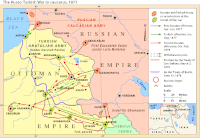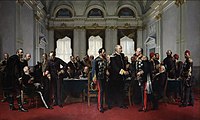
Eastern Rumelia was an autonomous province in the Ottoman Empire, created in 1878 by the Treaty of Berlin and de facto ended in 1885, when it was united with the Principality of Bulgaria, also under Ottoman suzerainty. It continued to be an Ottoman province de jure until 1908, when Bulgaria declared independence. Ethnic Bulgarians formed a majority of the population in Eastern Rumelia, but there were significant Turkish and Greek minorities. Its capital was Plovdiv. The official languages of Eastern Rumelia were: Bulgarian, Greek and Ottoman Turkish.
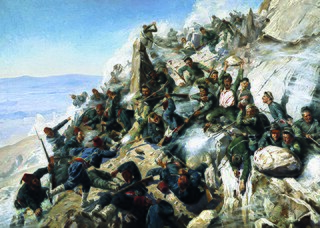
The Russo-Turkish War of 1877–1878 was a conflict between the Ottoman Empire and the Eastern Orthodox coalition led by the Russian Empire and composed of Bulgaria, Romania, Serbia, and Montenegro. Fought in the Balkans and in the Caucasus, it originated in emerging 19th-century Balkan nationalism. Additional factors included Russian goals of recovering territorial losses endured during the Crimean War of 1853–56, re-establishing itself in the Black Sea and supporting the political movement attempting to free Balkan nations from the Ottoman Empire.
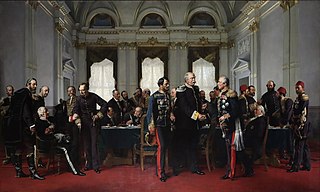
The Congress of Berlin was a meeting of the representatives of the era's six great powers in Europe, the Ottoman Empire and four Balkan states. It aimed at determining the territories of the states in the Balkan Peninsula after the Russo-Turkish War of 1877–78 and came to an end with the signing of the Treaty of Berlin, which replaced the preliminary Treaty of San Stefano, which had been signed three months earlier between Russia and the Ottoman Empire.

The 1878 Treaty of San Stefano was a treaty between the Russian and Ottoman empires signed at San Stefano, then a village west of Constantinople, on 3 March [O.S. 19 February] 1878 by Count Nicholas Pavlovich Ignatiev and Aleksandr Nelidov on behalf of the Russian Empire and by Foreign Minister Saffet Pasha and Ambassador to Germany Sadullah Bey on behalf of the Ottoman Empire. The treaty ended the Russo-Turkish War, 1877–78.
In diplomatic history, the Eastern Question was the issue of the political and economic instability in the Ottoman Empire from the late 18th to early 20th centuries and the subsequent strategic competition and political considerations of the European great powers in light of this. Characterized as the "sick man of Europe", the relative weakening of the empire's military strength in the second half of the eighteenth century threatened to undermine the fragile balance of power system largely shaped by the Concert of Europe. The Eastern Question encompassed myriad interrelated elements: Ottoman military defeats, Ottoman institutional insolvency, the ongoing Ottoman political and economic modernization programme, the rise of ethno-religious nationalism in its provinces, and Great Power rivalries.
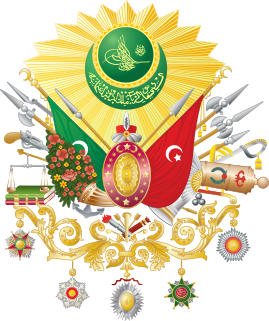
In the late eighteenth century, the Ottoman Empire faced numerous enemies. In response to these threats, the empire initiated a period of internal reform which came to be known as the Tanzimat, which succeeded in significantly strengthening the Ottoman central state, despite the empire's precarious international position. Over the course of the nineteenth century, the Ottoman state became increasingly powerful and rationalized, exercising a greater degree of influence over its population than in any previous era. The process of reform and modernization in the empire began with the declaration of the Nizam-I Cedid during the reign of Sultan Selim III and was punctuated by several reform decrees, such as the Hatt-ı Şerif of Gülhane in 1839 and the Hatt-ı Hümayun in 1856. By 1908, the Ottoman military became modernized and professionalized along the lines of Western European armies. The period was followed by the defeat and dissolution of the Ottoman Empire (1908–1922).

The Hamidian massacres, also referred to as the Armenian Massacres of 1894–1896 were massacres of Armenians in the Ottoman Empire that took place in the mid-1890s. It was estimated casualties ranged from 100,000 to 300,000, resulting in 50,000 orphaned children. The massacres are named after Sultan Abdul Hamid II, who, in his efforts to maintain the imperial domain of the collapsing Ottoman Empire, reasserted Pan-Islamism as a state ideology. Although the massacres were aimed mainly at the Armenians, they turned into indiscriminate anti-Christian pogroms in some cases, such as the Diyarbekir massacre, where, at least according to one contemporary source, up to 25,000 Assyrians were also killed.
This article about the Ottoman Armenian population presents some statistics of the Armenian population within the Ottoman Empire. Population size within the empire between 1914 and 1915 is a controversial topic. Most estimates by Western scholars range from 1.5 to 2.4 million. According to Britannica prior to 1915 and Samuel Cox, American Embassy in Istanbul from 1880-1886, it was 1.75 million and 2.4 million, respectively.
The rise of the Western notion of nationalism under the Ottoman Empire eventually caused the breakdown of the Ottoman millet concept. An understanding of the concept of the nationhood prevalent in the Ottoman Empire, which was different from the current one as it was centered on religion, was a key factor in the decline of the Ottoman Empire.

Western Armenia is a term to refer to the eastern parts of Turkey that are part of the historical homeland of the Armenians. Western Armenia, also refers to as Byzantine Armenia, emerged following the division of Greater Armenia between the Byzantine Empire and Sassanid Persia in 387 AD.

Mkrtich Khrimian was an Armenian Apostolic Church leader, educator, and publisher who served as Catholicos of All Armenians from 1893 to 1907. During this period he was known as Mkrtich I of Van.

The Armenian national awakening resembles that of other non-Turkish ethnic groups during the rise of nationalism under the Ottoman Empire in development of ideas of nationalism, salvation and independence in Armenia, as the Ottoman Empire tried to cover the social needs by creating the Tanzimat era, the development of Ottomanism and First Constitutional Era. However, the coexistence of the communities under Ottomanism proved to be a dysfunctional solution as did the Second Constitutional Era which also ignited the dissolution of the Ottoman Empire.

The following is the Timeline of Armenian national movement which is the collection of activities during the Armenian national movement.

The Armenian national liberation movement included social, cultural, but primarily political and military movements that reached their height during World War I and the following years, initially seeking improved status for Armenians in the Ottoman and Russian Empires but eventually attempting to achieve an Armenian state.
The foreign relations of the Ottoman Empire were characterized by competition with the Persian Empire to the east, Russia to the north, and Austria to the west. The control over European minorities began to collapse after 1800, with Greece was the first to break free, followed by Serbia. Egypt was lost in 1798–1805. In the early 20th century Austria-Hungary annexed Bosnia and Herzegovina, the Bulgarian Declaration of Independence soon followed. The Ottomans lost nearly all their European territory in the First Balkan War (1912–1913). The Ottoman Empire allied itself with Germany in the First World War, and lost. The British successfully mobilized Arab nationalism. The Ottoman Empire thereby lost its Arab possessions, and itself soon collapsed in the early 1920s. For the period after 1923 see Foreign relations of Turkey.

Armenians in the Ottoman Empire mostly belonged to either the Armenian Apostolic Church or the Armenian Catholic Church. They were part of the Armenian millet until the Tanzimat reforms in the nineteenth century equalized all Ottoman citizens before the law.

Armenian nationalism in the modern period has its roots in the romantic nationalism of Mikayel Chamchian (1738–1823) and generally defined as the creation of a free, independent and united Armenia formulated as the Armenian Cause. Armenian national awakening developed in the 1880s in the context of the general rise of nationalism under the Ottoman Empire. The Russian Armenia followed with significant causes. The Armenian Apostolic Church has been a great defender of Armenian nationalism, with leaders like Khrimian Hayrik who devoted his life to the peasantry. The establishment of modern Armenia (1991) and Armenian social fabric becoming more complex gradually decrease the political influence of Hay Dat and shifted towards a modern Armenian nationalism modeled as a liberal nationalism. On the other hand, the Armenian diaspora have "diaspora nationalism," which maintain that the threat of assimilation rather than economic advantage.

The 1876–77 Constantinople Conference of the Great Powers was held in Constantinople from 23 December 1876 until 20 January 1877. Following the beginning of the Herzegovinian Uprising in 1875 and the April Uprising in April 1876, the Great Powers agreed on a project for political reforms in Bosnia and in the Ottoman territories with a majority-Bulgarian population.
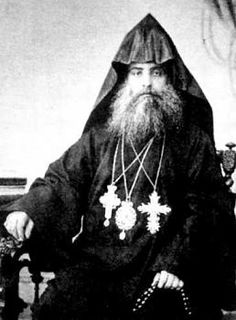
Matthew II Izmirlian was the Catholicos of All Armenians of the Armenian Apostolic Church at the Mother See of Holy Etchmiadzin in 1908–1910. He succeeded Mkrtich I Khrimian, who reigned as Catholicos from 1892 to 1907.

The Azerbaijan–Turkey border is a short 17 km (11 mi) long international border between the Republic of Azerbaijan and the Republic of Turkey. The border is located at the southeastern tip of the Iğdır Province on the Turkish side and at the northwestern tip of the Nakhchivan Autonomous Republic on the Azerbaijani side; running entirely along the Aras river, it is the shortest border for both countries.

